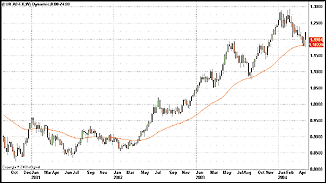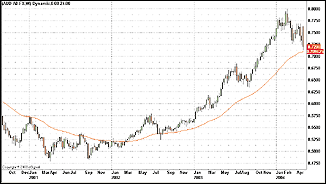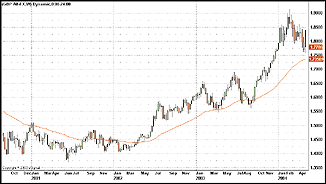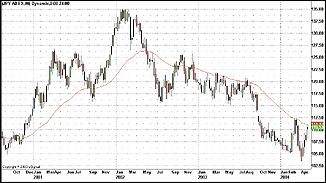EURO

Originally poised to be both rival and complement to the US dollar in the world of foreign exchange, the euro's miserable start in 1999 has become a stunning bull market by 2004. The euro is the currency of the 12 nations that make up the European Union (Belgium, Germany, Greece, Spain, France, Ireland, Italy, Luxembourg, the Netherlands, Austria, Portugal, and Finland). At present, the euro is the second most widely traded currency in the world.
Since breaking out in the spring of 2002, the euro has enjoyed a strong, vigorous bull market over the past two years, as the gentle slope of its 50-week exponential moving average (EMA) clearly shows. Fears of a euro top emerged in the spring of 2004, as the euro corrected to support at its 50-week EMA. Should the euro break down beneath its current levels of support, additional support lies in the 1.1380 range and, further down, in the 1.0765 area.
What they say: "Diversification has been going on and it has played a big part in the euro's rally, when a growth gap between the United States and the euro zone is so wide. Given the size of global currency reserves, even a 10% rise in a euro weighting means massive euro buying." -- Jim McCormick, head of FX research at Lehman Brothers, as quoted in Natsuko Waki's "Euro gains firmer footing in FX reserves contest," Forbes.com, April 28, 2004.
AUSTRALIAN DOLLAR

Heavily influenced by the role that commodity production and export play in the Australian economy, the Australian dollar (or "aussie," as forex traders refer to it) is among the world's foremost "commodity" currencies -- along with the South African rand and the New Zealand dollar. Less widely traded than finance currencies like the euro, the yen, or the US dollar, the Australian dollar is sought after by many traders and investors looking to exploit Australia's relationship with the developing economies of China and countries in southeast Asia.
In the span of a few short years, the Australian dollar has moved from being among the most underappreciated currencies to a chief refuge for those traders and investors looking to hedge their exposure to the US dollar. Breaking out in the early summer of 2002, the Australian dollar advanced in a smooth ascent for over a year and a half before correcting somewhat sharply in the first quarter of 2004.
What they say: "The [aussie] market is made up of a lot of cyclical companies, basic raw materials companies, for example, and I honestly don't think they have had a better period than they've had in the last couple of years. Industries such as banking and media should be benefiting ... and you've got expectations building for resource companies' profits because of China. I would have thought at this time in the cycle that the P/E ratio would be lower than it is, given that the good times are rolling." -- Peter Morgan, director and cofounder of fund management group 452 Capital, as quoted in "Good times to roll for a while longer," Sydney Morning Herald, March 22, 2004.
BRITISH POUND

When it comes to currencies competing against the US dollar, the British pound is third in line behind the euro and the yen. It is in some part the centrality of the London foreign exchange market that assists in keeping the British pound as widely traded as it is. Even so, most trading in pounds is Eur/Gbp and Gbp/Usd - that is, between pounds and euros, and pounds and US dollars.
The British pound broke out in the spring of 2002, along with a number of other global currencies such as the euro and the Australian dollar. The pound moved up strongly into early 2003 and consolidated over the middle part of the year, only to resume its strong uptrend late in 2003. As with the euro and the Australian dollar, the British pound has corrected somewhat in the first quarter of 2004, sinking back toward its 50-week exponential moving average (EMA).
What they say: "An increase in interest rates, not justified by the inflation outlook but by the desire to hold back house prices in order to lessen this risk, would have carried its own difficulties. Interest rates might well have needed to be raised very sharply, depressing growth. This could have confused the goal of policy, potentially moving inflation expectations away from the government's target. In the long run, this would have created further problems for operating monetary policy." -- Kate Barker, member, Monetary Policy Committee, Bank of England, from her speech at the CBI Yorkshire and Humber Annual Dinner, April 28, 2004.
YEN

The third most widely traded currency in the world -- after the US dollar and the euro -- the yen is, like the greenback and euro, considered a "finance currency" more affected by the fortunes of the Japanese equities, bond/interest rate, and real estate markets than by commodity production (as is the case with some other currencies).
After making a major top in the spring of 2002, the USD/JPY pair declined first sharply and then steadily throughout the balance of 2002 and 2003. By the first few weeks of 2004, USD/JPY appeared to be trying to establish an intermediate-term bottom, testing the 50-week exponential moving average for resistance on at least two occasions that spring.
What they say: "But even the Japanese will not postpone spending on consumption and investment forever. Rising corporate profits due variously to the China factor, vicious restructuring, and the digital revolution have triggered a stock-market recovery. That, together with belated Bank of Japan loose-money policies and a US economic recovery fueled by a regime that has ignored its own advice to Japan and indulged in massive deficit spending to overcome its own slump, has helped Japan shake off its deep deflationary pessimism. People are beginning to spend. What was once a vicious downward cycle could well turn into a strong upward trend." -- Gregory Clark, vice president of Akita International University, "Don't credit PM for recovery," The Japan Times, April 27, 2004.
Originally published in the July 2004 issue of Technical Analysis of STOCKS & COMMODITIES magazine. All rights reserved. © Copyright 2004, Technical Analysis, Inc.